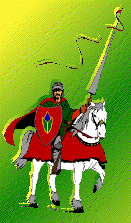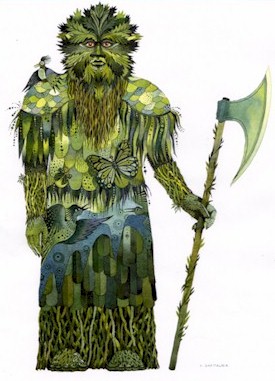
Sir Gawain and the Green Knight was written in the late fourteenth
century. To this day, no one knows the name of the author of the poem.
The poem was written in a dialect that is very hard to understand.
Alliteration and rhyme are combined to create unique stanzas, called
"Bob and Wheel." The term "Bob and Wheel" means that a poetic stanza
has long alliterative lines; then, there is a two syllable line
followed by a quatrain. The poem has several plots. One plot or theme
is temptation. "The poem is a medieval comedy of manners told from a
distinctly Christian viewpoint." In the lines from 366 to 443, the
poem shows how Sir Gawain is chivalrous and brave. In this passage,
there is action and symbolism that cause the characters' reactions.

In the beginning of the passage, not much action is going
on. The Green Knight then rides into King Arthur's house on his horse. He
gives a challenge to everybody in the hall. The king says that whoever
cuts the Green Knight's head will be a brave person. Then Sir
Gawain says that he will take the Green Knight's challenge. But, he
wants to know the Green Knight's name. Sir Gawain says,"Nor I know
you not, knight your name nor your court. But tell me truly thereof,
and teach me your name (Norton 210,line400-401). The Green Knight,
however, does not give his name to Sir Gawain. Instead, the Green
Knight says Sir Gawain has a year to find out where the Green Knight
lives. Once Sir Gawain discovers where the Green Knight lives, he will
know his name. The Green Knight says, "If I tell you true, when I have
taken your knock, and If you handily have hit, you shall hear
straightway of my house and my home and my own name" (Norton 210 lines 406-408).
At this point Sir Gawain does not know what to do. Sir Gawain asks the
Green Knight for directions to his house. But the Green Knight will not
give any clues to Sir Gawain, and he says, "That is enough in New Year,
you need say no more" which means that after the year is through, Sir
Gawain will know everything (Norton 210 line 404). If Sir Gawain follows
the right path, he will find the Green Knight's house. In the middle
of the passage, the beheading is takes place. Sir Gawain takes the ax
and gets ready to strike the Green Knight. To prepare, the Green Knight
moves his hair to uncover his neck. Sir Gawain holds the ax and puts
his left foot in front of him. He raises the ax and strikes the Green
Knight's head, and it falls on the floor. On the floor, the head rolls
and people find the head at their feet: "The blood gushed from the body,
bright on the green, Yet fell not the fellow, nor faltered a whit, But
stoutly he starts forth upon stiff shanks"(Norton 211, lines 429-431).
This quotation is describing what happened after the head is on the
floor. There is blood gushing from his neck, and the Green Knight does
not panic. He stands straight as if nothing has happened. The Green
Knight picks up his head by the hair and gets on the horse. The people
are afraid and in shock after seeing the incident.

In the passage there are many clues that help us understand who the the Green Knight really is and what kind of person he is. When the beheading does not affect the Green Knight, we learn that the Green Knight is immortal. He does not go into shock or die. Instead, he picks up his head and goes on with his life. He can never die no matter what anyone does to him. The constant mention of the color green also symbolizes immortality. Christmas trees and holly are both green. They are both pagan symbols that represent spring. If someone brings a Christmas tree or holly into a house, it is a way to remember spring or beginnings in the dead of winter The Green Knight never dies instead, he always starts over. In spring, people turn over a new leaf and begin again, just like the Green Knight.
The two characters in the passage are different, and it is evident in their behavior. When Sir Gawain prepares to participate in the challenge, he has courage. Sir Gawain is ready to face the challenge and will carry out what needs to be done without hesitance. His willingness also shows his loyalty to King Arthur. The Green Knight makes fun of King Arthur because no one wants to take the challenge. King Arthur has always said that his lords are fearless and brave, and now no one wants to play the Green Knight's game. Sir Gawain does not want King Arthur to be embarrassed. Without giving it a second thought, Sir Gawain decides to take the challenge that the Green Knight puts forth. Sir Gawain's loyalty to the King becomes evident when he takes the ax to strike the Green Knight. The Green Knight's actions shows that he is a magical character. As soon as he enters King Arthur's castle with on horse, it is evident he is a different person than the rest. In the passage it says that the Green Knight was green from top to bottom and his horse is also the same color. As soon as anyone reads this, it is it clear that the Green Knight is magical. But Sir Gawain's loyalty to the king does not make him afraid of the magical Green Knight's challenge.
This passage is significant because the beginning of the adventure starts here for Sir Gawain. When Sir Gawain takes the challenge, it shows loyalty and courageousness. When Sir Gawain cuts off the Green Knight's head, the challenge begins for him. When Sir Gawain tries to find the Green Knight's house, he also finds something about himself. The challenge is the beginning of Sir Gawain's discovery about himself. Sir Gawain beheads the Green Knight, and that is the first test he has to go through. When he goes to the castle he gets tested again. But, this time he does not pass the test. In the end of the journey, he feels humility because he lies and doesn't tell the truth. Sir Gawain was supposed to be loyal and truthful always. He thought that he would never lie. At the end of the journey he realized that he did lie which devastated him. This passage is important because it shows that the Green Knight is immortal which can help when reading this poem. If the reader does not understand that the Green Knight is magical then the some parts of the poem does not make sense. The Green Knight is significant to the poem because he is the one that tests and helps Sir Gawain discover something about himself. This passage is a little preview of what Sir Gawain will go through.
The following are a couple of links that talks about Sir Gawain and the Green Knight.
Text portion.
"Sir Gawain and the Green Knight" Online. Internet. March 13,1999 Available: http://gened.emc.maricopa.edu/academics/classes/english/enh221/gaw/gawover.htm
"Sir Gawain and the Green Knight" Online. Internet. March 13, 1999 Available: http://gened.emc.maricopa.edu/academics/classes/english/enh221/gaw/sggkintro.htm
Sir Gawain and the Green Knight. Norton Anthology of Literature. Ed. M.H. Abraams, et al. Vol 1. Sixth Edition New York: W.W. Norton & Company, 1993 pp 200-253
Sources for Images.
Dennis Scott, Gohmann Asphalt and Construction, Inc. The Green Knight picture Online. Internet. April 25, 1999 Available: http://www.stageone.org/fs.knight.htm
Capis Mundi. The Green Knight on horse Online. Internet. April 28, 1999 Available: http://www.aber.ac.uk/~cap96/greenk.html
If you have any questions or like to drop a line please e-mail: